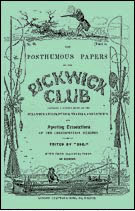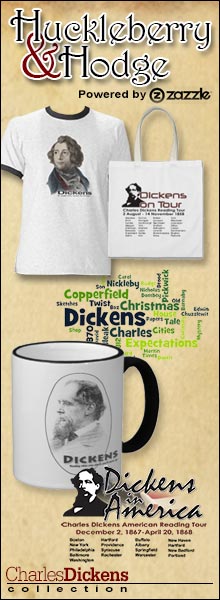Charles Dickens' Novels
Explore each of Charles Dickens' novels
Choose a book to explore:
 In his book The English Novel Walter Allen describes Charles Dickens as the "great novelist who was also the great entertainer, the greatest entertainer, probably, in the history of fiction " (Allen, 1954, p. 179). Dickens' genius as entertainer manifest itself in his first novel The Pickwick Papers. Pickwick, a loose collection of the zany adventures of Samuel Pickwick and his friends, was a departure from the traditional novel and was instantly a smash success. This success happened at a time when huge technological strides were being made in manufacturing and steam travel, helping Dickens' fame to spread worldwide.
In his book The English Novel Walter Allen describes Charles Dickens as the "great novelist who was also the great entertainer, the greatest entertainer, probably, in the history of fiction " (Allen, 1954, p. 179). Dickens' genius as entertainer manifest itself in his first novel The Pickwick Papers. Pickwick, a loose collection of the zany adventures of Samuel Pickwick and his friends, was a departure from the traditional novel and was instantly a smash success. This success happened at a time when huge technological strides were being made in manufacturing and steam travel, helping Dickens' fame to spread worldwide.
Dickens' ability to capture the imagination of his audience, many of them new to fiction due to a rise in literacy during the industrial revolution, was due largely to his amazing power of observation, incredible wit, unforgettable characters, and a command of the English language probably second only to Shakespeare (Smith, 1996, p. 13). His fiction provided a voice for the causes and frustrations of the poor and working classes helping to assure popularity across class boundaries.
The Serial Novel
"Make 'em laugh, make 'em cry, make 'em wait"1
Dickens wrote each installment with this type of publication in mind, many of the installments ended with a hook that kept the readers glued to the edge of their Victorian seats wondering what would happen next, thus ensuring the sales of the next installment. This type of arrangement worked perfectly for the workaholic Dickens, whose unbounded energy and inexhaustible supply of imagination enabled him to keep to the tight writing schedule required by serial publication for nearly 35 years, during which he missed only two deadlines: when his sister-in-law died during the writing of The Pickwick Papers and Oliver Twist (Ackroyd, 1990, p. 228), and his own death in 1870 while writing The Mystery of Edwin Drood (Davis, 1999, p. 251).
Later Editions
 Upon completion of serialization the works were issued as complete novels in one to three volumes with original, and in some instances, additional illustrations. Starting in 1847 the older novels were reissued in what was called the Cheap Edition, these were published in weekly and monthly parts, and then as complete novels. Eventually all of Dickens' novels were reissued in the Cheap Edition. The concept of the Cheap Edition was similar to today's practice of reissuing hardback novels as more affordable paperbacks (Schlicke, 1999, p. 204-205).
Upon completion of serialization the works were issued as complete novels in one to three volumes with original, and in some instances, additional illustrations. Starting in 1847 the older novels were reissued in what was called the Cheap Edition, these were published in weekly and monthly parts, and then as complete novels. Eventually all of Dickens' novels were reissued in the Cheap Edition. The concept of the Cheap Edition was similar to today's practice of reissuing hardback novels as more affordable paperbacks (Schlicke, 1999, p. 204-205).
Other editions published during Dickens lifetime include the Library Edition: a high quality set published without illustrations in 1858/59. This set was reissued between 1861 and 1874 with illustrations and was called the Illustrated Library Edition. In 1867 the Charles Dickens Edition was released. This edition featured new prefaces, written by Dickens, who also made minor corrections to the text. Chapman and Hall produced the Peoples Edition in 1865-1867, these were inexpensive monthly installments of the novels aimed at travelers in the very popular bookstalls popping up in railway stations all over Britain (Schlicke, 1999, p. 205).
Dickens' works were also published in America, sometimes simultaneously with the British edition and often with little or no compensation to the author or his publishers due to the lack of an international copyright law (Patten, 1978, p. 95-98). Dickens campaigned unsuccessfully for international copyright during his first American visit in 1842 (Forster, 1899, v. 1, p. 224-225). An English-American copyright law would not be enacted until 1891 (Davis, 1999, p. 189).
Charles Dickens novels continue to be published today in popular series like the Oxford Illustrated Edition, which include the original illustrations, and the Penguin English Library's paperback edition.

Used with permission - The Pierpont Morgan Library, New York. MA 97.
All of Charles Dickens' novels were submitted to the printer in pen-and-ink (and blobs!). The typesetter would have to carefully decipher the sometimes illegible handwriting, written in the passion of the creative moment. The first typewriters came on the market in 1874, four years after Dickens' death. This is a portion of the original manuscript for the opening stave of A Christmas Carol.
Note 1 - Attributed to Charles Reade (1814-1884) Back



